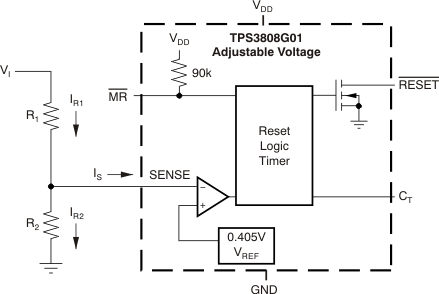SLVA450B February 2011 – April 2021 TL7770-12 , TL7770-5 , TPS3513 , TPS3514 , TPS3606-33 , TPS3613-01 , TPS3617-50 , TPS3618-50 , TPS3619-33-EP , TPS3620-33-EP , TPS3805H33-EP , TPS3808-EP , TPS3818G25 , TPS386000 , TPS386000-Q1 , TPS386040 , TPS386596 , TPS60120 , TPS60121 , TPS60122 , TPS60123 , TPS60124 , TPS60125 , TPS60130 , TPS60131 , TPS60132 , TPS60133 , TPS60140 , TPS60141 , TPS60204 , TPS60205 , TPS60210 , TPS60211 , TPS60212 , TPS60213 , TPS61130 , TPS61131 , TPS62050 , TPS62051 , TPS62052 , TPS62054 , TPS62056 , TPS62110 , TPS62110-EP , TPS62111 , TPS62111-EP , TPS62112 , TPS62112-EP , TPS65000 , TPS65001 , TPS65010 , TPS65011 , TPS65012 , TPS65013 , TPS65014 , TPS65020 , TPS65021 , TPS65022 , TPS65023 , TPS650231 , TPS65023B , TPS650240 , TPS650241 , TPS650241-Q1 , TPS650242 , TPS650243 , TPS650243-Q1 , TPS650244 , TPS650245 , TPS650250 , TPS65050 , TPS65053 , TPS65055 , TPS650830 , TPS65086 , TPS65720 , TPS65721 , TPS65810 , TPS65811 , UC1543 , UC1903 , UC2543 , UCC2946 , UCC3946
2 Designing with the TPS3808G01
As Figure 2-1 illustrates, the SENSE pin input of the TPS3808G01 is compared to a 0.405 V internal reference (VREF). A voltage divider is used to scale down the monitored voltage (VI) to the level of the SENSE pin. The voltage divider ratio is selected based on the desired trip point of VI at which the SVS should generate a reset. This trip point is the threshold voltage, VIT. An accurate trip point is necessary to prevent the system from resetting too early or too late.
 Figure 2-1 Example Resistor
Divider into the SENSE Pin Comparator (TPS3808G01 Adjustable Version)
Figure 2-1 Example Resistor
Divider into the SENSE Pin Comparator (TPS3808G01 Adjustable Version)When selecting the resistors to use, R2 should be chosen first; then solve for R1 to achieve the desired VIT. Equation 1 shows the calculation for R1, given a value of R2, while Equation 2 calculates the actual value of VIT based on the selected values for R1 and R2.


However, as a result of the leakage current (IS), the voltage at the SENSE pin (VS) is not what is expected at the desired VIT. The actual VS can be found using Equation 3. The actual input threshold voltage varies because of the leakage current, and can be calculated with Equation 4. The resulting accuracy of the divider can be found using Equation 5.



Including the effect of the leakage current, the current drawn by the divider, IR1, is simply the current that passes through the top resistor in the divider. This value can be found using Equation 6. The maximum current into the divider occurs when IS is positive (flowing into the pin; refer to Figure 2-1). Equation 6 shows that current drawn from the divider varies almost linearly with the input voltage. When the leakage current is very small and/or the resistors in the divider are small, Equation 6 simplifies to Ohm's law.

By rearranging Equation 5 and solving for R2, we can derive Equation 7. This formula can be used to design a voltage divider to meet a desired accuracy requirement. Note that a negative accuracy is equivalent to using a negative leakage current, and produces the same resistance (R2) that exists when both accuracy and leakage are positive. To state it differently, if the leakage current is negative (that is, flowing out of the pin), the threshold voltage is lower than expected, which equates to negative accuracy.

By rearranging Equation 4 and solving for R2, we can derive Equation 8. With this formula, we can now design a voltage divider to achieve a desired current, IR1.
